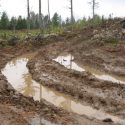Questions remain on what makes a perfect rain garden
Since their public introduction more than 10 years ago, rain gardens — small garden plots that are designed to collect and filter storm water — have created quite a storm among environmentally minded homeowners. But as their popularity has grown, so have opinions about what makes the perfect rain garden. Many gardeners fill their plots with deep-rooted prairie plants, which they believe help water permeate the soil and replenish groundwater supplies. But some contend that turfgrasses do just as well.
“There are a lot of stories out there, and stories are good — they provide a starting point for science,” says soil science professor Nick BalsterNick Balster. “But what we need are some repeated, controlled experiments that rise above bias.”
Balster is doing just that. With graduate students Marie Johnston and Sara Rouse, he is growing rain garden plots blanketed by soil, shrubs and prairie plants, and tracking where the water they collect winds up. He now fields several calls a month from people looking for advice, especially on which vegetation to plant.
His answer so far: It depends.
Balster and his students have found that, contrary to popular belief, actively growing prairie gardens seem to let little rainwater past their roots. “When people look at their prairie gardens after a rain and see no water, they tend to think all that water went through the ground and into groundwater pools,” he says. “Our trialswith residential-sized gardens suggest this may not be true. What appears to be happening in our experiments is that the prairie plants can suck a substantial amount of water up and put it back into the atmosphere.”
That capacity could make prairie plants an ideal setup for trapping contaminated runoff from a parking lot, Balster says. Toxins like lead and zinc may end up staying behind in plant tissues and soil, making them easy to remove.
With its shallow, dense root mass, turf, on the other hand, seems to act like a temporary sponge, sopping up rain and then releasing it slowly into the soil, says Balster. It might therefore be a better choice when groundwater recharge is the goal, although this needs testing.

Soil science professor Nick Balster is a growing a variety of rain garden plots and tracking which are the most effective for collecting water.
Photo: Wolfgang Hoffmann
But sometimes the objective is simply to capture as much water as possible, regardless of whether it ends up in the earth or sky. In this case, a study by horticulture professor John Stier and graduate student Jake Schneider suggests that what matters most is sizing a rain garden properly and surrounding it with a berm.
“What we’ve found so far is that berms are the main factor controlling runoff,” says Schneider. “I think the bottom line is that if you put in a rain garden, it’s going to be incredibly effective at this, no matter what type of vegetation you have.”
Lots of questions remain, though. How does performance change as rain gardens age and plants become better established? Can easier-to-tend shrubs substitute for fussier prairie plants? What role do the root systems play in late winter-early spring, when aboveground parts haven’t yet grown?
“Just like anything else in science, this has become a much more fun and interesting story than just ‘prairie versus turf,’” says Balster.
Stay tuned.


